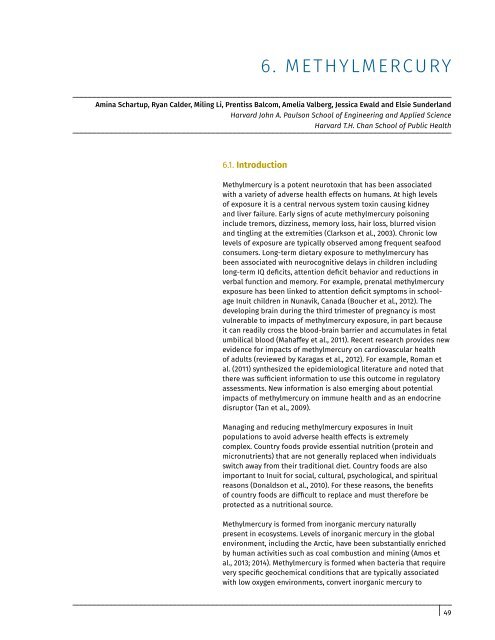Lake Melville
1rw7Mns
1rw7Mns
You also want an ePaper? Increase the reach of your titles
YUMPU automatically turns print PDFs into web optimized ePapers that Google loves.
6. METHYLMERCURY<br />
Amina Schartup, Ryan Calder, Miling Li, Prentiss Balcom, Amelia Valberg, Jessica Ewald and Elsie Sunderland<br />
Harvard John A. Paulson School of Engineering and Applied Science<br />
Harvard T.H. Chan School of Public Health<br />
6.1. Introduction<br />
Methylmercury is a potent neurotoxin that has been associated<br />
with a variety of adverse health effects on humans. At high levels<br />
of exposure it is a central nervous system toxin causing kidney<br />
and liver failure. Early signs of acute methylmercury poisoning<br />
include tremors, dizziness, memory loss, hair loss, blurred vision<br />
and tingling at the extremities (Clarkson et al., 2003). Chronic low<br />
levels of exposure are typically observed among frequent seafood<br />
consumers. Long-term dietary exposure to methylmercury has<br />
been associated with neurocognitive delays in children including<br />
long-term IQ deficits, attention deficit behavior and reductions in<br />
verbal function and memory. For example, prenatal methylmercury<br />
exposure has been linked to attention deficit symptoms in schoolage<br />
Inuit children in Nunavik, Canada (Boucher et al., 2012). The<br />
developing brain during the third trimester of pregnancy is most<br />
vulnerable to impacts of methylmercury exposure, in part because<br />
it can readily cross the blood-brain barrier and accumulates in fetal<br />
umbilical blood (Mahaffey et al., 2011). Recent research provides new<br />
evidence for impacts of methylmercury on cardiovascular health<br />
of adults (reviewed by Karagas et al., 2012). For example, Roman et<br />
al. (2011) synthesized the epidemiological literature and noted that<br />
there was sufficient information to use this outcome in regulatory<br />
assessments. New information is also emerging about potential<br />
impacts of methylmercury on immune health and as an endocrine<br />
disruptor (Tan et al., 2009).<br />
Managing and reducing methylmercury exposures in Inuit<br />
populations to avoid adverse health effects is extremely<br />
complex. Country foods provide essential nutrition (protein and<br />
micronutrients) that are not generally replaced when individuals<br />
switch away from their traditional diet. Country foods are also<br />
important to Inuit for social, cultural, psychological, and spiritual<br />
reasons (Donaldson et al., 2010). For these reasons, the benefits<br />
of country foods are difficult to replace and must therefore be<br />
protected as a nutritional source.<br />
Methylmercury is formed from inorganic mercury naturally<br />
present in ecosystems. Levels of inorganic mercury in the global<br />
environment, including the Arctic, have been substantially enriched<br />
by human activities such as coal combustion and mining (Amos et<br />
al., 2013; 2014). Methylmercury is formed when bacteria that require<br />
very specific geochemical conditions that are typically associated<br />
with low oxygen environments, convert inorganic mercury to<br />
49


